Can You Freeze Breakfast Casserole
Yes, you can freeze breakfast casserole, making it an excellent option for meal prep and convenient morning meals. Whether baked or unbaked, breakfast casseroles can be stored in the freezer for up to 3 months when properly wrapped and sealed. To freeze, cool the casserole completely, wrap it tightly in plastic wrap and aluminum foil, and label it with the date and cooking instructions. When you're ready to eat, thaw the casserole overnight in the refrigerator and reheat it in the oven until it reaches an internal temperature of 165°F (74°C). By following proper freezing techniques and using freezer-friendly ingredients, you'll guarantee your breakfast casserole maintains its quality and flavor. The key to success lies in the details of preparation and storage.
This post may contain affiliate links. If you make a purchase through these links, I may earn a commission at no additional cost to you. Additionally, portions of this post may be generated using artificial intelligence (AI) technology. While we strive for accuracy, please be aware that AI-generated content may not always be perfect and should be fact-checked when necessary.
The Spatula Scoops
- Breakfast casseroles can be frozen for up to 3 months, whether unbaked or fully cooked.
- Cool the casserole completely before freezing to prevent ice crystal formation and maintain texture.
- Wrap the casserole tightly in plastic wrap and aluminum foil to prevent freezer burn.
- Thaw frozen casseroles overnight in the refrigerator for best results before reheating.
- Reheat thawed casseroles at 375°F (191°C) for 40-45 minutes, or 50-60 minutes if still frozen.
Benefits of Freezing Breakfast Casserole
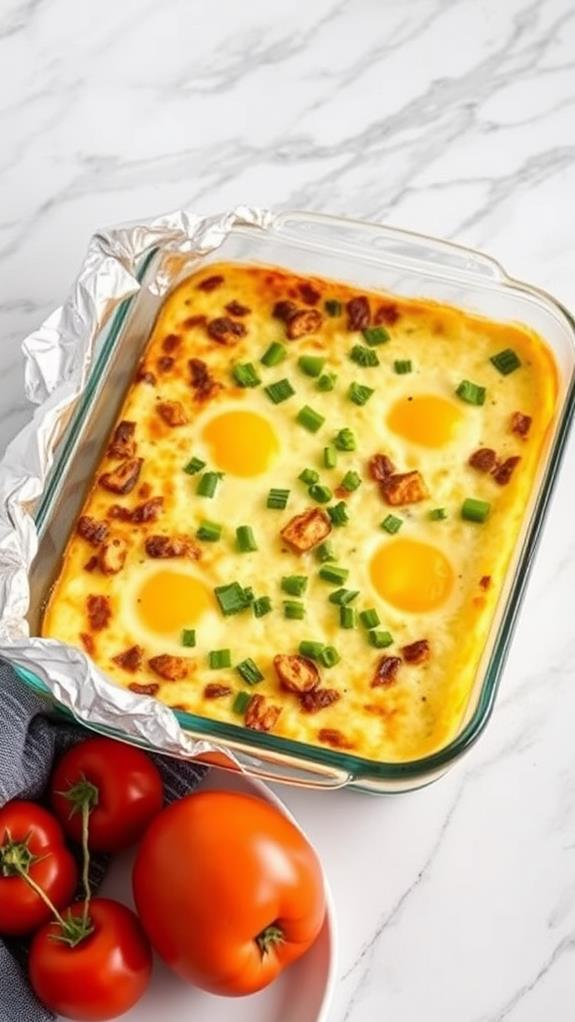
With time at a premium in today's fast-paced world, freezing breakfast casseroles offers a game-changing solution for busy mornings. By engaging in convenient meal prep, you'll be able to whip up healthy breakfasts quickly without extended cooking time. Freezing breakfast casserole allows you to store uncooked dishes for up to 3 months, preserving their quality and flavor for later use.
To guarantee ideal texture, it's vital to thaw frozen casseroles overnight in the refrigerator before baking. This process allows the ingredients to meld and guarantees even cooking. Additionally, freezing breakfast casserole is a cost-effective strategy, enabling bulk preparation and helping reduce food waste by utilizing ingredients before they spoil.
Don't limit yourself to unbaked casseroles; baked breakfast casseroles can also be frozen. This approach provides leftovers that can easily last for up to 5 days in the refrigerator and be reheated for quick meals. By incorporating this freezing technique into your routine, you'll save time, money, and effort while making sure you always have a delicious breakfast option at your fingertips.
Preparing Casserole for Freezing
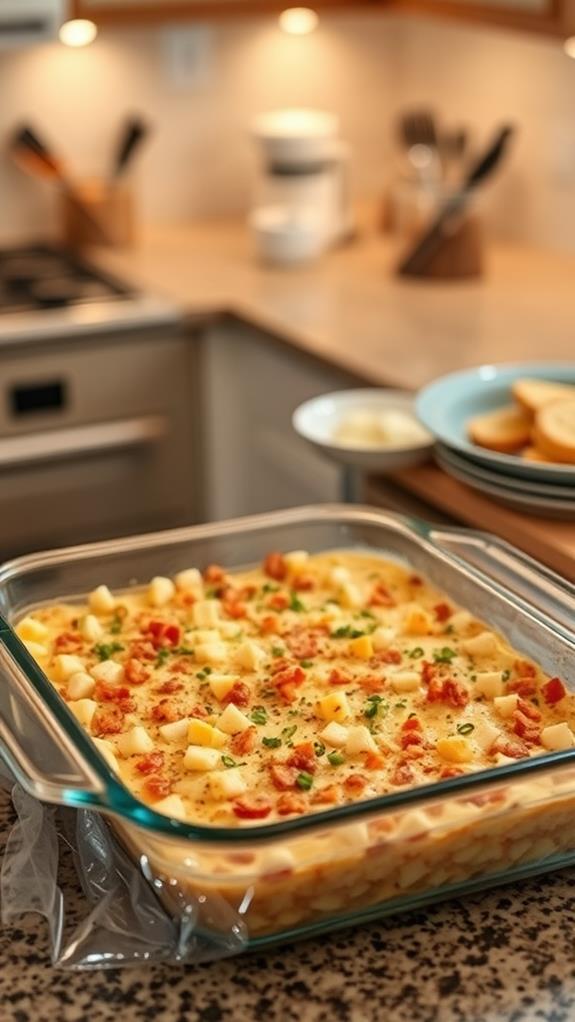
When preparing your breakfast casserole for freezing, it's essential to let it cool completely to room temperature before packaging. You'll want to wrap the casserole tightly in plastic wrap, followed by a layer of aluminum foil, to create an airtight seal that prevents freezer burn and maintains flavor. Don't forget to label your casserole with the dish name and date of preparation, which will help you keep track of how long it's been in the freezer and guarantee you use it within the recommended timeframe.
Proper Cooling Process
After you've baked your delicious breakfast casserole, it's vital to cool it properly before freezing. The cooling process is key for maintaining ideal freshness and preventing condensation, which can affect the texture. Allow your casserole to cool at room temperature for about 30 minutes. This step guarantees that excess moisture doesn't accumulate when you cover it.
Once cooled, carefully cover the casserole with plastic wrap to seal in moisture. Then, wrap it in aluminum foil for extra protection against freezer burn. It's significant to freeze your casserole within 2 hours of cooking to minimize bacterial growth and maintain quality. Before placing it in the freezer, label the casserole with the date and contents. This simple step aids in easy identification and helps you track its storage time, which can be up to 3 months.
When storing your casserole, verify the freezer temperature is at 0°F (-18°C) or lower. This temperature is crucial for preserving the casserole's quality and safety for an extended period. By following these steps, you'll be able to enjoy your breakfast casserole weeks or even months after you've prepared it.
Airtight Packaging Techniques
Proper packaging is vital when preparing your breakfast casserole for freezing. To guarantee maximum freshness and prevent freezer burn, you'll need to use airtight packaging techniques. Start by allowing your casserole to cool completely; this step is significant to avoid ice crystal formation, which can affect the texture.
Once cooled, wrap your casserole tightly in plastic wrap or aluminum foil. This creates a barrier against air and moisture, which are the main culprits behind freezer burn. For an extra layer of protection, place the wrapped casserole in a resealable freezer bag or an airtight container.
Don't forget to label your package with the date. This simple step helps you track storage time, as freeze casseroles can maintain quality for up to three months. When you're ready to enjoy your casserole, remember to thaw it properly. Transfer it from the freezer to the refrigerator and let it thaw overnight. This slow thawing process guarantees even heating when you bake it later.
Labeling and Dating
To round off your freezer prep, labeling and dating your breakfast casserole is vital. Grab a permanent marker and clearly write the dish's name and assembly date on the container. This simple step guarantees freshness and quick identification when you're rummaging through your freezer later. Don't stop there; include specific notes like cooking instructions or additional toppings needed. These details will streamline your cooking process when it's time to bake the casserole.
Remember, freezing typically preserves your breakfast casserole for up to three months. By marking the date, you'll easily track when it needs to be used or discarded. Avoid using regular adhesive labels, as they can peel off in the freezer. Instead, opt for freezer-friendly tape to secure your labels, making sure they stay put.
Before sealing your labeled container, remove any excess air from the packaging. This important step prevents freezer burn, maintaining the quality of your baked casserole upon reheating. By following these labeling and packaging techniques while preparing your breakfast casserole for freezing, you'll set yourself up for a hassle-free and delicious meal in the future.
Freezing Methods and Storage Tips
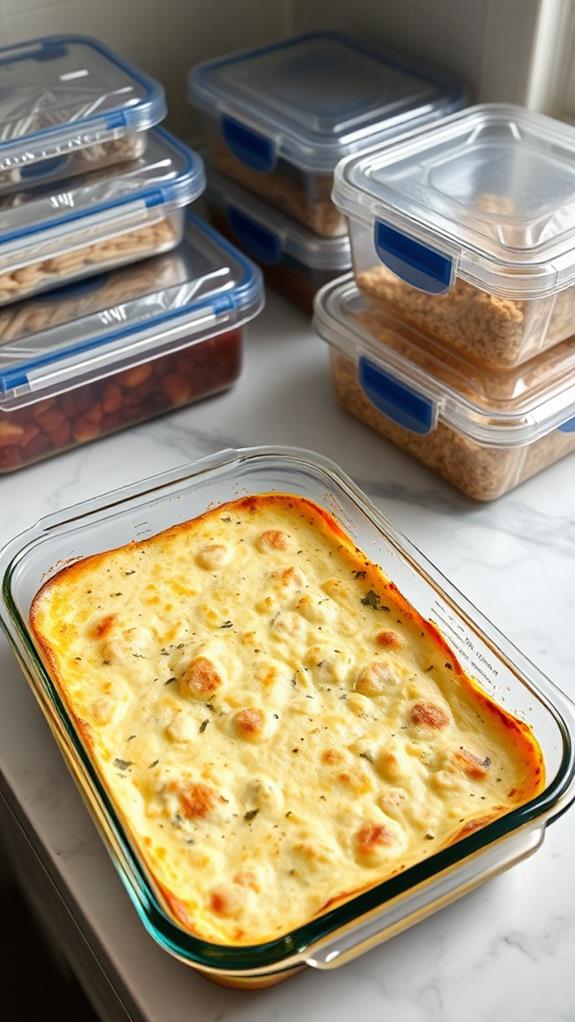
When freezing your breakfast casserole, you'll want to use proper techniques to guarantee long-term storage success. Start by tightly wrapping your casserole in plastic wrap and aluminum foil, which creates a barrier against freezer burn and helps maintain quality for up to three months. For uncooked casseroles, it's best to chill the assembled dish in the refrigerator for an hour before freezing, as this promotes even freezing throughout the casserole.
Proper Freezing Techniques
Freezing breakfast casseroles correctly guarantees you'll have a delicious meal ready when you need it. To properly freeze your breakfast casserole, cover it tightly with plastic wrap and aluminum foil. This will prevent freezer burn and maintain moisture for up to 3 months. If you've already baked your casserole, cool it completely before wrapping to preserve texture and flavor.
Don't forget to label your containers with the date and contents. This helps you keep track of how long they've been stored, guaranteeing ideal usage within the 3-month timeframe. When you're ready to enjoy your casserole, thaw it overnight in the refrigerator for even temperature distribution.
Here's a quick guide to freezing and reheating your breakfast casserole:
| Step | Unbaked Casserole | Baked Casserole |
|---|---|---|
| Preparation | Assemble as usual | Cool completely |
| Wrapping | Plastic wrap + foil | Plastic wrap + foil |
| Labeling | Date and contents | Date and contents |
| Freezing | Up to 3 months | Up to 3 months |
| Thawing | Overnight in fridge | Overnight in fridge |
When you're ready to bake, remove the plastic wrap and increase baking time by 10-15 minutes for frozen casseroles to guarantee they're heated through.
Long-term Storage Solutions
For long-term storage solutions, you'll want to contemplate both freezing methods and storage tips to keep your breakfast casserole in top condition. When it comes to unbaked casseroles, you can freeze them for up to 2 months without significant quality loss. To do this, wrap the casserole tightly with plastic wrap and then aluminum foil to prevent freezer burn. For baked casseroles, you've got a bit more flexibility, as they can be stored in the freezer for up to 3 months.
Before you wrap and freeze a baked casserole, verify it's completely cooled. This step is essential for maintaining texture and preventing ice crystals from forming. When you're ready to enjoy your frozen breakfast casserole, remember to thaw it in the refrigerator overnight. This method guarantees even cooking and helps preserve the dish's original texture. To reheat, set your oven to 375°F (191°C) and bake until the internal temperature reaches the appropriate level for doneness, typically taking 40-45 minutes. By following these long-term storage techniques, you'll be able to enjoy your breakfast casserole whenever the craving strikes, without compromising on taste or quality.
Thawing and Reheating Instructions
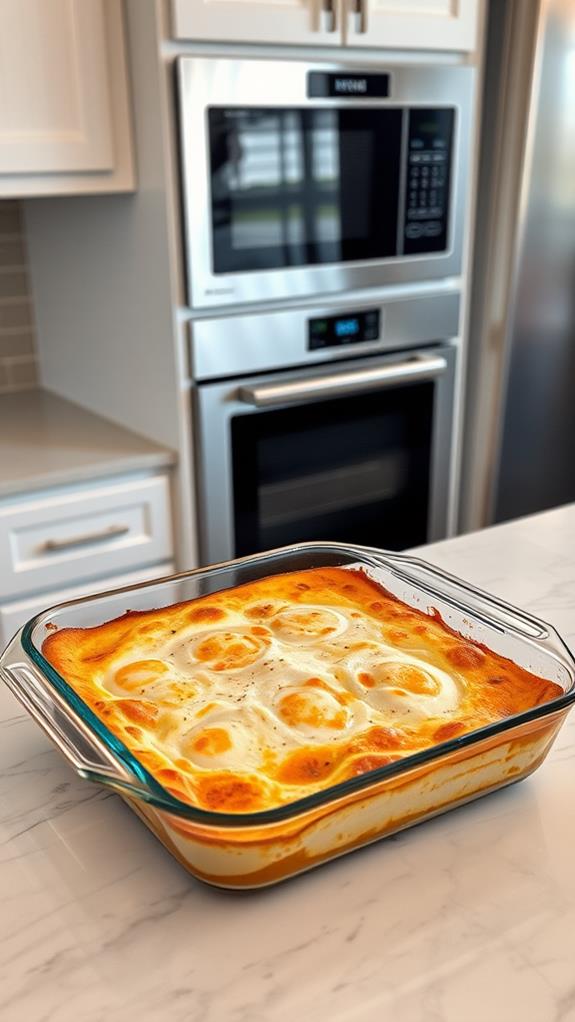
To enjoy your frozen breakfast casserole, proper thawing and reheating are vital. For ideal results, place your frozen casserole in the refrigerator overnight. This method guarantees even thawing and maintains food safety. If you're short on time, you can use your microwave's defrost setting, but be sure to check frequently for even thawing without cooking.
When you're ready to reheat, preheat your oven to 375°F (191°C). If your casserole is fully thawed, bake it for 40-45 minutes until it's heated through and the top is golden. For a frozen casserole, increase the baking time to 50-60 minutes. It's essential to verify the internal temperature reaches at least 165°F (74°C) for safe consumption.
Don't forget about leftovers! You can store baked breakfast casserole in the refrigerator for up to five days. For a quick meal, simply reheat portions in the microwave. Remember, proper thawing and reheating not only guarantee food safety but also help maintain the casserole's texture and flavor. By following these guidelines, you'll be able to enjoy your breakfast casserole whenever you want, without compromising on taste or quality.
Best Ingredients for Freezable Casseroles

Selecting freezer-friendly ingredients is key to creating a delicious breakfast casserole that'll withstand the test of time. When planning your freezable breakfast casserole, start with a solid base of bread or hash browns. These ingredients maintain their texture and absorb flavors well during the freezing process.
For proteins, opt for pre-cooked and cooled options like sausage or ham. This prevents excess moisture from forming during freezing, ensuring your casserole remains tasty when reheated. When it comes to vegetables, choose those that freeze well, such as bell peppers, spinach, or broccoli. These veggies will retain their nutritional value and flavor after thawing.
Cheese is an essential component of any breakfast casserole. Select varieties like cheddar or gouda, which freeze well and offer a creamy texture when baked from frozen. Avoid cheeses that may become crumbly after freezing.
Freezer-Friendly Variations and Recipes
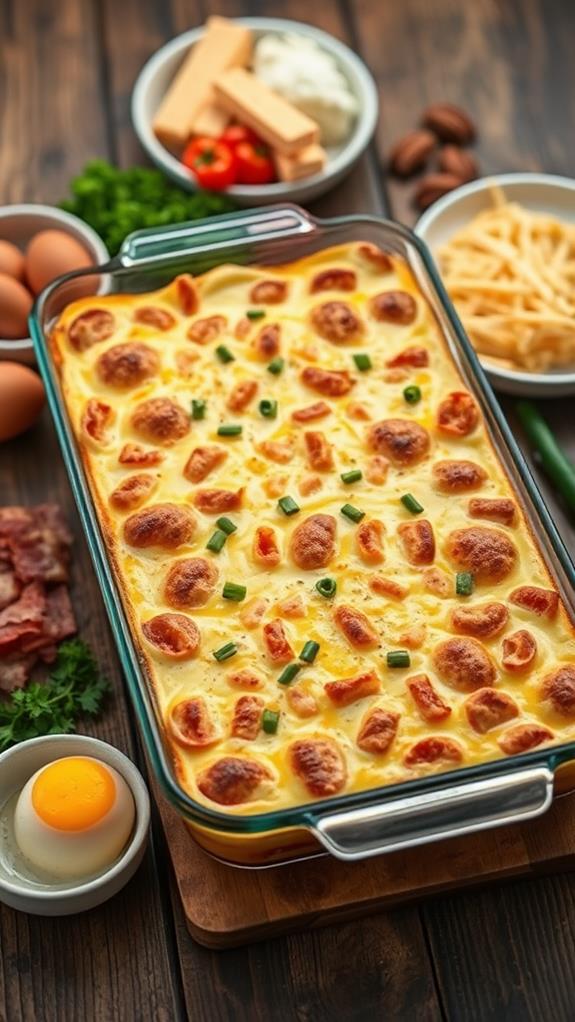
Now that you've got the basics of ingredient selection down, let's explore some tasty variations and recipes for your freezer-friendly breakfast casseroles. A popular base for a freezable breakfast casserole includes a mixture of hash browns, eggs, cheese, and cooked sausage. To make ahead, you'll want to cover tightly with plastic wrap before freezing. When you're ready to enjoy, thaw overnight in the refrigerator for best results.
Here are some flavor-enhancing ingredients and variations to try:
| Ingredient | Variation 1 | Variation 2 | Variation 3 | Variation 4 |
|---|---|---|---|---|
| Protein | Bacon | Ham | Turkey | Vegetarian |
| Cheese | Cheddar | Swiss | Mozzarella | Feta |
| Veggies | Bell peppers | Spinach | Mushrooms | Onions |
| Herbs | Basil | Thyme | Rosemary | Parsley |
| Extras | Salsa | Hot sauce | Sour cream | Avocado |
When preparing your egg mixture, consider adding herbs or spices to maintain taste after freezing and reheating. You can also experiment with different cheese combinations, placing some on top for a golden crust. Remember, you can freeze your casserole both before and after baking, giving you flexibility in your meal prep routine.
Common Mistakes to Avoid
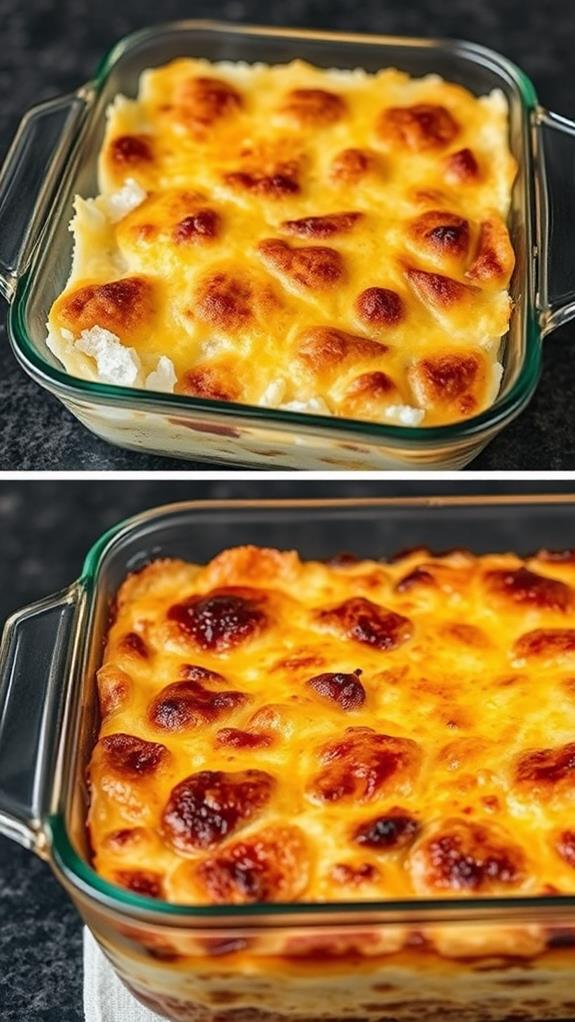
Despite the convenience of freezer-friendly breakfast casseroles, several common pitfalls can compromise their quality. When freezing your breakfast casserole, you'll want to avoid using fresh, uncooked potatoes. These can retain excess moisture, leading to a soggy texture when baked. Instead, pre-cook your potatoes before assembling the casserole.
Another mistake is not allowing your casserole to cool completely before freezing. This can cause ice crystal formation, negatively impacting both texture and flavor integrity. To prevent freezer burn and maintain flavor, wrap your casserole in a double layer of plastic wrap followed by aluminum foil.
Be cautious with delicate ingredients like fresh herbs or cream, as they may not withstand the freezing and thawing process well. Consider adding these after reheating for best results.
Don't forget to label your frozen casserole with the date and cooking instructions. This helps guarantee proper reheating and aids you in tracking how long it's been in the freezer. Remember, the maximum recommended freezer time is three months for ideal quality.
Frequently Asked Questions
Do Breakfast Casseroles Freeze Well?
Yes, breakfast casseroles freeze well when you prepare them properly. You can store uncooked casseroles for up to three months without significant quality loss. To freeze, wrap your casserole tightly with plastic wrap and aluminum foil to prevent freezer burn. When you're ready to use it, thaw the casserole overnight in your refrigerator for the best texture and flavor. You can also freeze baked casseroles after they've cooled completely. Remember to wrap them tightly before storing for maximum freshness.
Is It Better to Freeze an Egg Casserole, Cooked or Uncooked?
You'll generally get better results freezing an uncooked egg casserole. This method preserves texture and allows flavors to meld during baking. Uncooked casseroles can last up to 3 months frozen, while cooked ones are best within 2-3 months. When you're ready to use it, thaw your uncooked casserole overnight in the fridge before baking. If you've frozen a cooked casserole, you can reheat it directly from frozen, but it'll need about 50-60 minutes at 375°F (191°C) to heat through properly.
Can You Freeze a Fully Cooked Casserole?
Did you know that freezing a fully cooked casserole can extend its shelf life by up to 3 months? Yes, you can freeze a fully cooked casserole. Once it's cooled completely, wrap it tightly in plastic wrap and aluminum foil to prevent freezer burn. When you're ready to eat it, thaw it overnight in the refrigerator. To reheat, place the thawed casserole in a preheated 375°F oven for about 25-30 minutes, ensuring the center reaches a safe temperature. It's a great way to save time and have meals ready.
Can Sausage Casserole Be Frozen?
Yes, you can freeze sausage casserole. It's a great way to save time and have meals ready for later. You'll want to wrap your uncooked casserole tightly in plastic wrap and foil before freezing. It'll keep well for up to 3 months. When you're ready to eat it, thaw it overnight in the fridge. Bake it at 375°F for 50-60 minutes, checking to make sure it's cooked through. You can also freeze leftovers from a cooked casserole for easy reheating.
Conclusion
You've now navigated the nuances of freezing breakfast casseroles, from preparation to palate-pleasing perfection. By following these freezing fundamentals, you'll save time and savor satisfying meals. Remember to wrap well, label clearly, and thaw thoroughly. With these techniques tucked away, you're ready to create countless casserole combinations. Whether you're preparing for busy mornings or planning potlucks, freezing your breakfast casseroles can be a game-changer. So, start stocking your freezer and simplify your morning routine.





